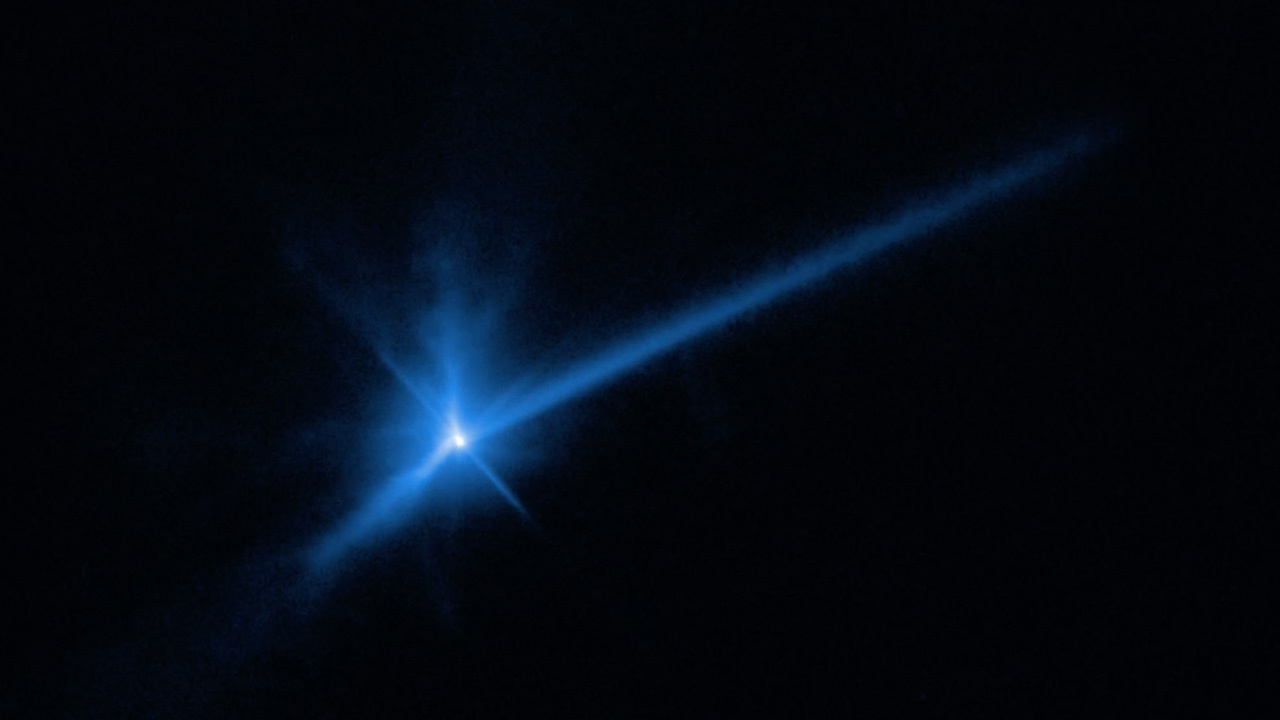Slam! Hubble sees strange changes in asteroid dust after DART collision (video)
Science continues to roll in from DART's epic September 2022 asteroid crash.
The famed Hubble Space Telescope tracked dramatic hour-by-hour changes in deep space caused by a NASA probe's deliberate asteroid crash.
NASA's Double Asteroid Redirection Test (DART) mission slammed into a small space rock called Dimorphos in late September 2022, aiming to test-drive a technique for deflecting an asteroid on a collision course with Earth. (There are no imminent asteroid threats to our planets, but practice makes perfect.)
Fresh imagery from the Hubble Space Telescope released today (March 1) shows dust and debris flying at high speed away from Dimorphos and its larger asteroid companion, Didymos, after DART's impact. The collision is believed to have thrown about 1,000 tons of ancient asteroid material into space.
Related: Behold the 1st images of DART's wild asteroid crash!
"We've never witnessed an object collide with an asteroid in a binary asteroid system before in real time, and it's really surprising. I think it's fantastic. Too much stuff is going on here. It's going to take some time to figure out," Jian-Yang Li of the Planetary Science Institute in Tucson, Arizona, said in a statement released by the Space Telescope Science Institute (STScI) in Baltimore, which operates Hubble's science program.
The fresh imagery was accompanied by a study, led by Li in collaboration with 63 other DART team members, on Wednesday (March 1) in the journal Nature. The paper is one of five published in Nature Wednesday, which together give a detailed overview of the DART impact and its aftermath.
Information based on Hubble's work indicates at least three stages of Dimorphos debris evolution. First an ejecta cone was formed, then the debris furled into the asteroid's orbit, and finally the tail moved behind the asteroid due to the pressure of the solar wind, the stream of charged particles flowing constantly from our sun.
Get the Space.com Newsletter
Breaking space news, the latest updates on rocket launches, skywatching events and more!
The newly released Hubble movie begins with footage from roughly 1.3 hours after impact, showing Dimorphos and Didymos at such a distance that the two space rocks cannot be resolved individually. Roughly 2 hours after the event, you can see debris moving at speeds exceeding 4 mph (6.4 kph) an hour, fast enough to overcome the gravitational pull of the asteroid system.

The cone shape began forming about 17 hours after impact. "The most prominent structures are rotating, pinwheel-shaped features. The pinwheel is tied to the gravitational pull of the companion asteroid, Didymos," STScI officials wrote in the statement.
Then the last stage shows debris sweeping behind the asteroid, "where the lightest particles travel the fastest and farthest from the asteroid," STScI officials added. But the processes have yet to be understood, as Hubble saw the tail splitting into two streams for a few days and the mechanism by which that happened is not clear.
Numerous instruments on Earth and in space imaged the DART impact, and more results will come from these various investigations as the data is parsed, understood and processed.
Elizabeth Howell is the co-author of "Why Am I Taller?" (ECW Press, 2022; with Canadian astronaut Dave Williams), a book about space medicine. Follow her on Twitter @howellspace. Follow us on Twitter @Spacedotcom or Facebook.
Join our Space Forums to keep talking space on the latest missions, night sky and more! And if you have a news tip, correction or comment, let us know at: community@space.com.

Elizabeth Howell (she/her), Ph.D., was a staff writer in the spaceflight channel between 2022 and 2024 specializing in Canadian space news. She was contributing writer for Space.com for 10 years from 2012 to 2024. Elizabeth's reporting includes multiple exclusives with the White House, leading world coverage about a lost-and-found space tomato on the International Space Station, witnessing five human spaceflight launches on two continents, flying parabolic, working inside a spacesuit, and participating in a simulated Mars mission. Her latest book, "Why Am I Taller?" (ECW Press, 2022) is co-written with astronaut Dave Williams.









